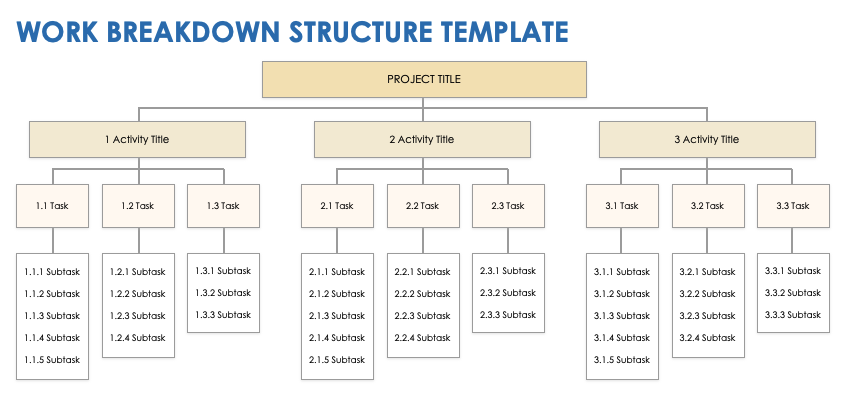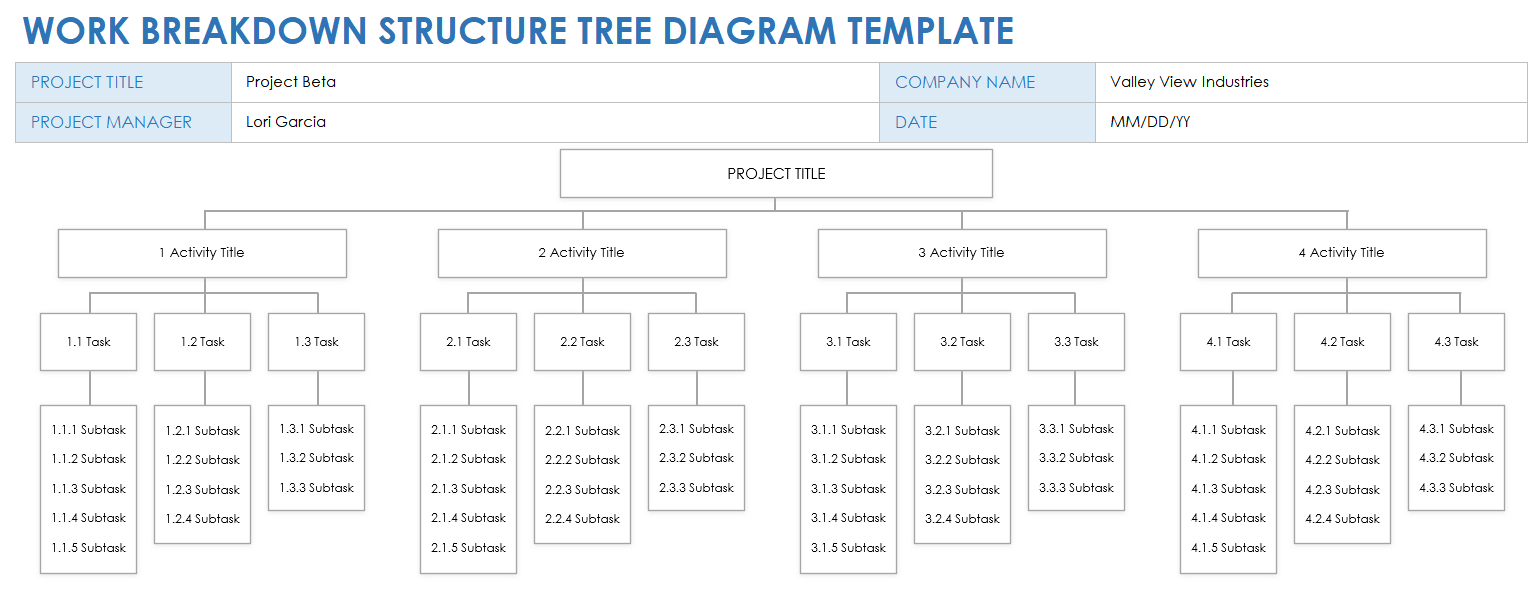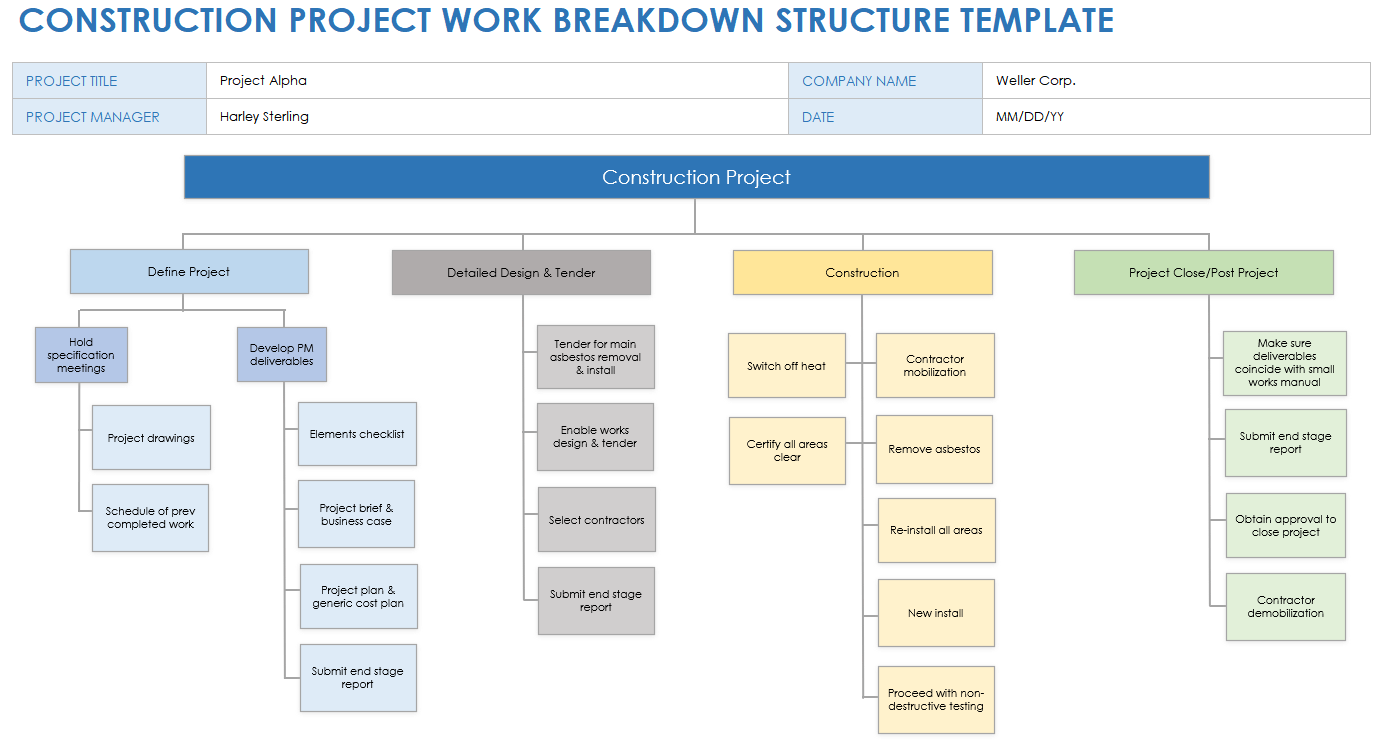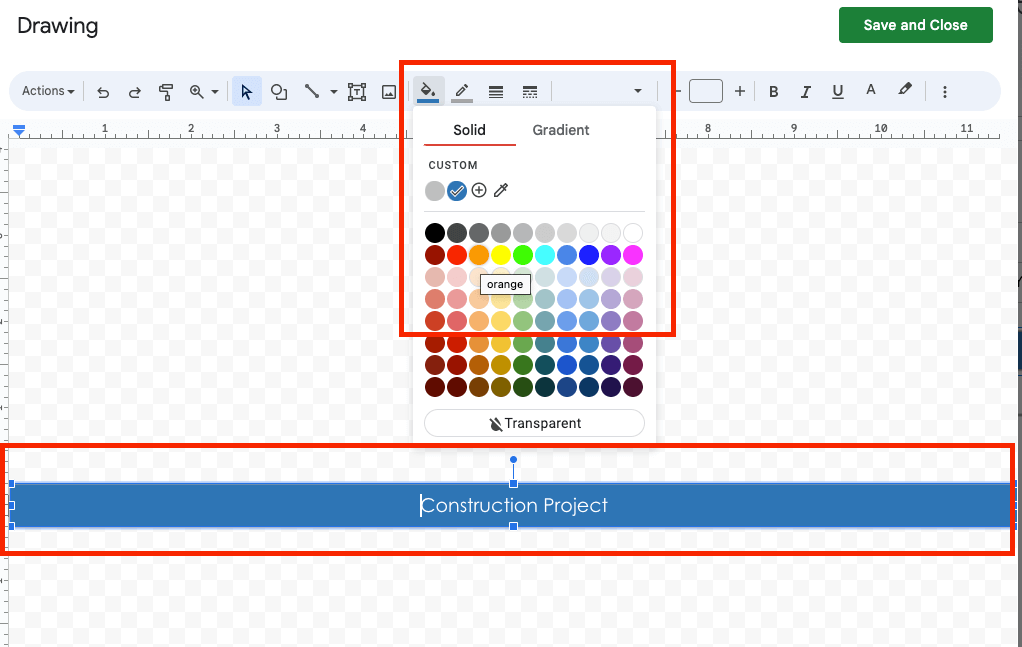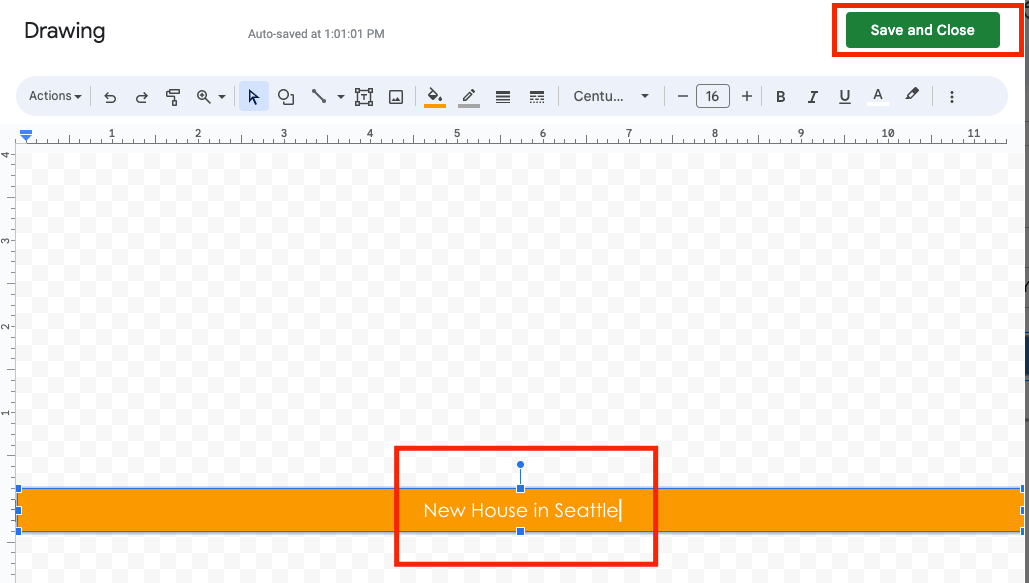Work Breakdown Structure Template
Download a Work Breakdown Structure Template for
Google Sheets | Google Docs
Use this basic work breakdown structure template to organize project tasks and deliverables into a hierarchical structure. Start with the top-level project objective and break it down into smaller, more detailed tasks. This process continues until each task is small enough to be easily assigned to a specific team member or group. This WBS template helps project managers more easily identify and manage each task's dependencies, timelines, and resources. The template serves as a roadmap for the project team, helping them understand the project's scope, schedule, and budget, as well as track progress toward completion.
Check out this article full of work breakdown structure templates in a variety of formats to make sure you are using the proper template for your project.
Also visit this guide to getting started with WBS for a complete explanation of the power of this important organizational toolset.
Work Breakdown Structure with Gantt Chart Template for Google Sheets
Download the Work Breakdown Structure with Gantt Chart Template for Google Sheets
Use this template with its integrated Gantt chart template to track your project’s progress. This simple, customizable template is a perfect tool for most use cases, as it allows you to track duration, completion status, and deadlines all in one place. The Gantt chart makes it easy to visualize progress and focus on when individual tasks or subsets of tasks need to be completed.
Visit this page of helpful information and tips on WBS templates and Gantt charts to learn more about the fusion of these powerful tools.
Work Breakdown Structure Levels Template
Download a Work Breakdown Structure Levels Template for
Google Sheets | Google Docs
This WBS template organizes a project into levels, showing how each subtask is related to the larger project and to the tasks immediately up- and downstream. This layout creates efficiencies in your work planning by visually highlighting the relationships between tasks, departments, or personnel.
You can also try a Smartsheet WBS template to manage and track up to 4,000 tasks. The template can calculate your team’s progress using established best practices.
Work Breakdown Structure Tree Diagram Template
Download a Work Breakdown Structure Tree Diagram Template for
Google Sheets | Google Docs
Use this work breakdown structure template to organize and manage your next large project. The tree diagram works by starting with the project objective at the top of the hierarchy and branching out into smaller, more detailed tasks at each subsequent level. The diagram is similar to an organizational chart, with each level branching out into more specific tasks and deliverables. This format allows project managers to easily see how each task relates to the project objective and to identify the critical path for completing the project on time and within budget.
Construction Work Breakdown Structure Template
Download a Construction Work Breakdown Structure Template for
Google Sheets | Google Docs
The often complicated nature of construction projects lends itself to the use of a WBS template. Use this construction-specific template to organize your build and gain a visual understanding of the interplay between the various aspects and stages of your project. Avoid costly subcontractor inefficiencies and overlap, and prioritize the right tasks by developing a proper hierarchy of needs with this robust template.
Check out this article on construction workflow and the use of WBS templates, full of great advice and instructive examples.
What Is a WBS Template?
A WBS template is a tool for creating work breakdown structures for project management. A WBS template breaks a large project into smaller components called work packages. Project managers can use the template to schedule, track, and manage work packages.
A WBS template typically includes a list of tasks or deliverables that a team needs to complete for the project, and it organizes them into a hierarchical structure. The structure can be represented as a chart or diagram, with the project at the highest level, followed by the major phases or deliverables. Finally, the WBS will show the specific tasks or work packages that make up each deliverable.
You can customize WBS templates to fit the specific needs of a project, industry, or organization. You can use them as a starting point for creating a WBS or as a reference guide for project team members to ensure that all necessary tasks are accounted for in the project plan. A well-structured WBS can help ensure a project is completed within budget and on time, and that it receives approval from stakeholders.
Benefits of Using a WBS Template
Using a WBS template provides the benefit of creating a structure that helps project managers organize the work for a project. The pre-built layout supplies a visual of the project’s scope and whether you have the necessary team and resources.
Here’s an overview of the benefits of using a work breakdown structure template:
- Pre-Formatted Layout: A lot of detail goes into creating a WBS. By using a template that already has the format built out, you can save time and stay aware of what still needs to be added to the WBS.
- Built-in Organization: One goal of doing a WBS is to organize the work necessary to complete a project. A WBS template provides a structure that you use to fill in the details that are already organized.
- Easily Assign Work Packages: Most WBS templates have a place to add the person or team assigned to a work package.
- Automatically Track Project Progress: You can quickly see when a project is running behind schedule when you use a WBS template with a built-in Gantt chart. The Gantt chart shows how long tasks take, dependencies, predecessors, and milestones, so it’s easy to determine at a glance if the project might be delayed.
- Allocating Resources: Once you complete a WBS template, you’ll know what resources are necessary to finish a project. Looking at the work package assignments will quickly let you know if your team is stretched too thin.
How to Use a WBS Template
When using a WBS template, follow these steps to effectively plan, manage, and execute your project. The template provides a structure that can help ensure it is completed on time, within budget, and to the satisfaction of stakeholders.
- Define Project Scope
Before you can create a work breakdown structure, you need a clear understanding of the project scope. This includes defining the project goals, objectives, deliverables, and requirements, so you can determine the major phases and work packages that will make up your WBS. By following this step, you can also customize your WBS template more efficiently and effectively. - Customize the WBS Template
Use a WBS template as a starting point and customize it to fit the specific needs of your project. This might include adding, removing, or modifying the different levels and elements of the WBS to ensure it accurately reflects the project scope and requirements. - Identify Project Phases
The first level of the WBS should be the major phases of the project. These are the broad categories that define the different stages, such as planning, design, development, testing, and deployment. - Organize Phases into Work Packages
For each project phase, break down the work into smaller, more manageable work packages. These work packages should be specific, measurable, and time-bound, as well as represent the smallest units of work that can be assigned to a team member. - Assign Tasks to Team Members
Once you define the work packages, assign them to team members or groups. This step helps account for each task and informs everyone of who is responsible for each piece of the project. - Track Progress
Use the WBS to track progress and monitor the status of each task and work package. By monitoring it closely, you can identify any issues or delays, as well as make adjustments to the project plan as needed. - Update the WBS
As the project progresses, update the WBS to reflect any changes or updates to the project scope, deliverables, or requirements. This type of due diligence helps ensure that the WBS remains an accurate representation of the project and can be used as a reference guide throughout the project lifecycle.
How to Customize a WBS Template
Download a WBS template from this page. After downloading a template, you can easily customize it by changing colors and adding your work details.
Use the following step-by-step guide to download, open, and customize the construction WBS template.
1. Download and Rename the WBS Template
- Download the construction WBS template for Google Sheets.
- Click File in the menu bar, and click Make a copy.
- Rename the template. Choose a folder on your Google Drive to save the template. Click the Make a copy button.
Complete the Data in the Construction WBS Template
- Double-click on cell B1 to rename the template.
- Select all the copy (press command+A for Apple OS or Control+A on a PC keyboard). Type in a new name.
- Click the cells next to the project title, company name, project manager, and date, and add your project’s information.
- Change the copy or the color of any of the preformatted squares in the WBS layout, and double-click on the cell. (Note: Our example is for the overarching construction project bar, but the same steps apply for all the boxes in the WBS.) A Drawing window will appear on the screen.
- Double-click on the Construction Project image.
- Click on the color-fill icon in the menu, and click on a new color for the box.
- The color of the box will update.
- Click in the colored box in the Drawing pop-up window, select all, and type a name for your construction project to update the text.
- Click the Save and Close button in the top-right corner of the pop-up window. The change will appear on the template.
Easily Create a Work Breakdown Structure in Smartsheet and Seamlessly Share it with Your Team and Stakeholders
From simple task management and project planning to complex resource and portfolio management, Smartsheet helps you improve collaboration and increase work velocity -- empowering you to get more done. The Smartsheet platform makes it easy to plan, capture, manage, and report on work from anywhere, helping your team be more effective and get more done. Report on key metrics and get real-time visibility into work as it happens with roll-up reports, dashboards, and automated workflows built to keep your team connected and informed. When teams have clarity into the work getting done, there’s no telling how much more they can accomplish in the same amount of time. Try Smartsheet for free, today.
